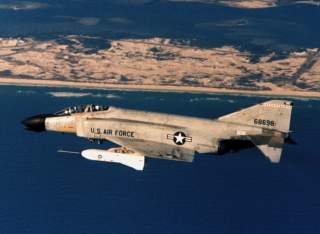The F-4 Phantom Fighter Is Over 60 Years Old (And It Refuses to Go Away)
And these are all of the reasons why.
But in the end, love is not rational, or it would not be love. My theory is that the Phantom is beloved not just because it was successful, but because it wasn’t supposed to be. Of all mankind’s works of destruction, jet fighters tend to be the most aesthetically elegant, whether the compact grace of an F-16 or the slender symmetry of a French Mirage 5. The Phantom was as aesthetic as putting wings on an elephant. But like the Ugly Duckling of the Andersen fairy tale, the Phantom redeemed itself.
There is no particular reason for the world’s love affair with the F-4 Phantom.
Beautiful it was not, nor graceful, nor aesthetic. The Phantom earned nicknames like “Rhino” and “Double Ugly.” It was said to be proof of an amazing aeronautical principle: that “a brick can fly if you stick a big enough engine on it.”
(This first appeared several years ago.)
The Phantom was a capable aircraft, setting several speed records soon after it first flew in 1958. But then again, there have been many equally capable aircraft over the years. In the 1950s and 1960s, there was a flock of high-performance American jets in the skies or on the drawing boards: the F-101, F-102, F-104, F-105, F-106 and F-111. Where are they now? Footnotes and photos in aviation books.
The Phantom was prolific, with 5,195 copies serving in the air forces of twelve nations. But not half as prolific as its Cold War nemesis, the Soviet MiG-21 (NATO codename: Fishbed) with which it dueled in the skies over Vietnam and the Middle East.
The F-4 originated as a U.S. Navy carrier-based interceptor that was supposed to pick off Soviet bombers with radar-guided missiles. Like the F-35, the F-4 became the prime aircraft of the air force (which bought three times as many as the navy) and the marines.
The Phantom had more than its share of flaws, and detractors to point them out. The two-seat, 15-ton “Lead Sled” was heavy and lacked maneuverability. Its two big J-79 engines pumped out black smoke that pinpointed the Phantom’s position like a trail of breadcrumbs. Because it was designed at a time when the United States was convinced that air-to-air guided missiles had made aerial cannon obsolete, the F-4 lacked a gun that was sorely, sorely missed when it ended up dogfighting nimble North Vietnamese MiGs.
With this list of black marks, the Phantom should have been consigned to one of those Top 10 Worst Aircraft lists. But just how much affection the “Flying Brick” had earned was demonstrated recently at an airshow that Japan’s air force held to mark the retirement of its F-4s next year in favor of the F-35 stealth fighter. Phantom fans from all over the world attended.
Part of the Phantom’s appeal was its flexibility. By the early 1970s, it had been equipped with a cannon, and its pilots had learned how to fly against nimbler MiGs. The aircraft was a true multi-tasker: it served or was modified as an interceptor, air superiority fighter, reconnaissance plane, and Wild Weasel defense suppression aircraft. Part of it was luck. The pilots who flew it—Americans, Israelis and Iranians—were simply better trained and employed more flexible tactics than the Arab, Vietnamese and occasionally Soviet MiG pilots they flew against. Like other Western aircraft, the F-4 had better electronics than Soviet aircraft.
But in the end, love is not rational, or it would not be love. My theory is that the Phantom is beloved not just because it was successful, but because it wasn’t supposed to be. Of all mankind’s works of destruction, jet fighters tend to be the most aesthetically elegant, whether the compact grace of an F-16 or the slender symmetry of a French Mirage 5. The Phantom was as aesthetic as putting wings on an elephant. But like the Ugly Duckling of the Andersen fairy tale, the Phantom redeemed itself.
Michael Peck is a contributing writer for the National Interest. He can be found on Twitter and Facebook.
Image: Wikimedia

